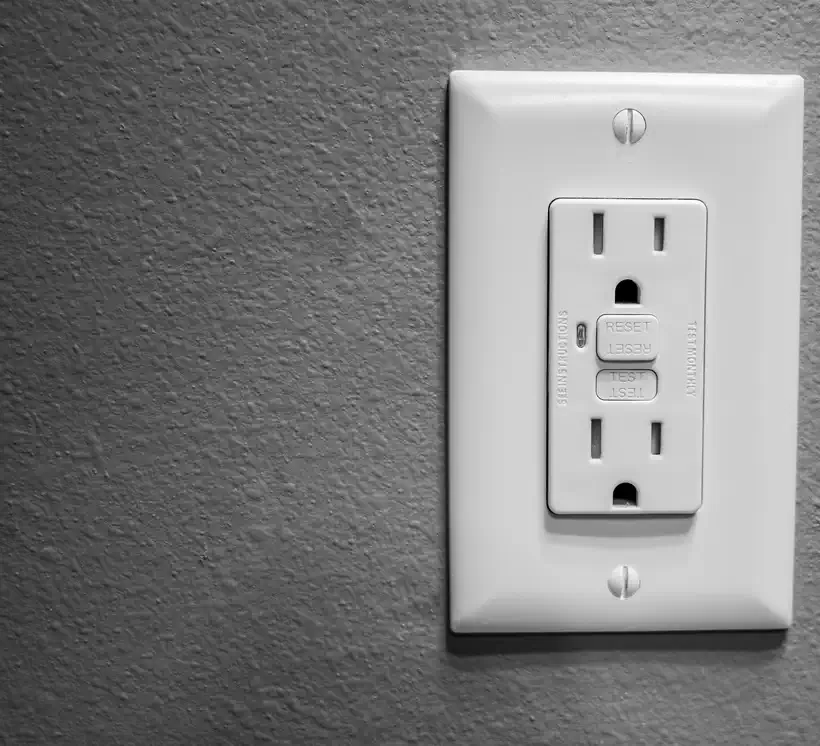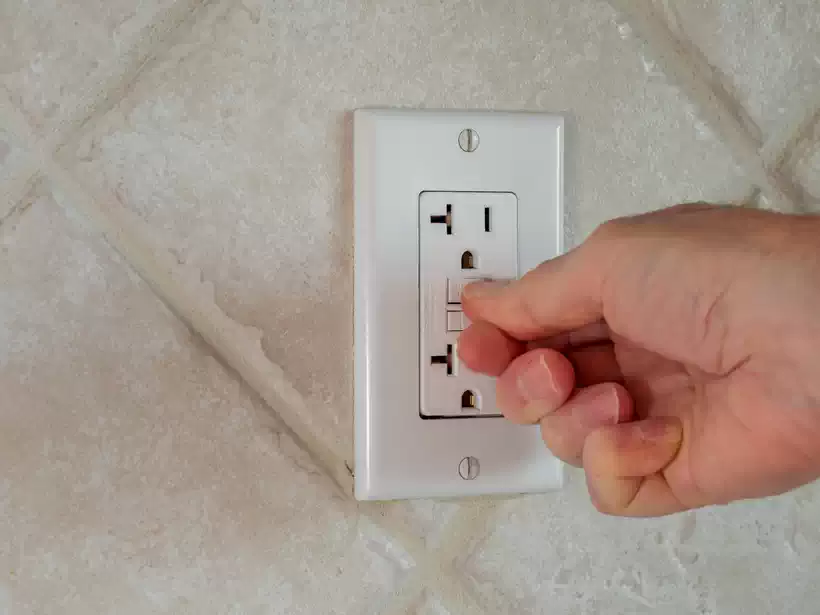Electrical outlets and circuit breakers can be confusing, especially if you’re unsure what the difference is between them.
It’s important to know the difference between a GFCI outlet and a regular outlet because GFCI outlets can help protect you from electrical shock.
A GFCI (Ground Fault Circuit Interrupter) is a type of electrical outlet that helps prevent injuries by shutting off power automatically when it detects an imbalance in the current flow. Regular outlets don’t offer this protection, so installing GFCI outlets is important, particularly in areas where water and electricity are present, like kitchens, bathrooms, and basements.
Read through the entire article to get valuable insights about the GFCI, its need, how does a GFCI work to fulfill those needs, the difference between GFCI and other circuit breakers and regular outlets, and other details.
The Need for GFCI
To appreciate the need and function of the Ground Fault Circuit Interrupter or similar devices in protecting humans against electric shock, you need to familiarise yourself with the effect of current magnitudes, duration, and frequency on the human body.
The human body is particularly sensitive to currents in the frequency range of 50 to 60 Hz. It can withstand higher currents (than power frequency currents) at 25 Hz frequency on the lower side and 3 kHz on the higher side.
The effects of electrical current in the increasing order of magnitude as per IEEE 80: 2000 are:
- One mA – Perception threshold where the person feels a slight tingling sensation.
- 1 to 6 mA – Termed as the let-go currents, unpleasant but do not impair the ability to control muscles and release the object.
- 9 to 25 mA – Painful with loss of ability to release the energized object. The higher electrical current can induce muscle contractions that may make breathing difficult.
- 60 to 100 mA – Ventricular fibrillation, breathing inhibition, or heart stoppage may occur, causing permanent injury or even death.
The aim of any electrical shock prevention system is to avoid reaching the ventricular fibrillation threshold by carefully designing the grounding system so that injury or death can be avoided.
The relationship between the magnitude of electric current and its time duration that humans can withstand is inverse, which means higher currents can be tolerated for a smaller time and vice versa. The following equation, by Dalziel and others, describes that the energy absorbed by the body is related to the non-fibrillating current magnitude IB for durations between 0.03 to 3.0 seconds.
SB = (IB)2 x ts
where IB is the current passing through the body,
ts is the time for exposure, and
SB = empirical constant, depending on the body weight, frequency of the electrical system, and other considerations.
For a 50 Kg human body weight at 50 to 60 Hz frequency, the equation becomes IB = 0.116/sqrt(ts). Please note that IB = 0.116 A or 116 mA for ts = 1 second.
This is the current that 99.5% of humans can safely withstand without fibrillation for ts time.
From the above equations, it is clear that high-speed ground fault clearance is a very important consideration in shock protection as:
- Faster fault clearance reduces the probability of somebody getting exposed to the fault.
- Injury or damage will be less if the exposure time gets reduced.
With this background, let us understand the difference in working principles of the normal circuit breakers and ground fault circuit interrupters that makes GFCIs, the equipment of choice to prevent electric shocks.
Difference Between Circuit Breakers (CBs) & GFCI
Circuit breakers that are generally found in a home’s electrical system primarily carry overload and short-circuit protection, designed to protect against overloads, whereby the electrical circuit draws more than the intended electric current or short-circuits – failure of insulation causing a fault between the conductors or any conductor to ground. The circuit breakers trip when the current in the protected electrical circuits exceeds the set limit.
The time of tripping of the CBs is inversely proportional to the fault current, which means the lower the fault current, the more tripping time.
Ground faults, by nature, have low magnitudes of current. The issue gets compounded if the feeding cables have a larger length and impedance, thereby reducing the ground-fault current further for the normal circuit breaker to sense and act.
We have seen above that time is of great essence in avoiding household electrocutions. That is where GFCI protection plays a big role, as GFCI senses a very low value of ground-fault current and trips the entire circuit in minimal time. In addition to electrical shocks, it also protects against electrical fires, ensuring complete electrical safety.
What is GFCI, and how does it work?
From the ongoing discussion, a ground fault circuit interrupter (GFCI) is a ground fault protection device that senses any hazardous electrical current flowing to the ground that is likely to flow through a human body if someone comes in contact and opens the circuit. Some of the GFCIs can also detect neutral-to-ground faults.
National Electrical Code defines a “ground fault” as a conducting connection (it may be intentional or accidental) between any electric conductor and any other conducting material that is grounded or that may become grounded.
There are various types and designs for GFCI protection, which we will discuss in subsequent sections. Let us consider a basic arrangement to explain the functioning of any typical GFCI protection.
A GFCI device has a high permeability core with a current sensing transformer wound. All the electrical wiring or cable under GFCI protection, including the neutral wire, is passed through the center of this core. These cables or wires act as the primary for protection, while the coil wound on the core acts as secondary.
You can see the arrangement in the diagram below.
How Does a GFCI Work – Diagram
Under normal circumstances, the electricity flows through the hot wire and returns through the neutral wire; the sum of the outlet current matches the return current, and the magnetic fields due to the two currents cancel each other. Hence, no current is induced in the secondary coil of the protection.
If a ground fault occurs in any of the connected electrical devices, a part of the current flows through the unintended path to the ground and does not return through the neutral, causing an imbalance in the magnetic field. This induces an electrical current in the sensing coil that commands the main circuit breaker to trip, typically within 25 ms. The sensitivity of GFCI devices is usually set to detect ground faults causing a difference of 5 mA in the outgoing and return currents.
Where should GFCIs be used?
You need to have GFCI protection for all 125 V to 250 V receptacle outlets fed by single-phase branch circuits rated 150 V or less to the ground.
- Dwellings – GFCI outlets are required for areas like bathrooms, outdoors, garages and accessories, basements, crawl spaces, laundry rooms, kitchen countertop surfaces, sinks, bathtub or shower stalls, boathouse, etc.
- Non-Dwellings and Structures – All the receptacles in the following areas must carry a GFCI outlet – bathrooms, kitchens, rooftops, outdoors, sinks, indoor wet locations, locker rooms, garages, crawl spaces, and unfinished areas of basements.
What’s the difference between a GFCI outlet & a regular outlet?
As would be clear to you by now, a GFCI receptacle carries the proper GFCI protection for the circuit it is feeding electrical power to, whereas the regular NEMA outlets are electrically protected only by their upstream CBs, which may not be very effective in protecting against ground faults.
Types of GFCI

The various types of GFCI include:
- Standard outlet – It looks similar to conventional outlets with the “test button” and “Reset button” in addition. May have guide lights or pilot lights to indicate the status.
- Multi-location GFCI Outlet – You can wire one GFCI unit to protect multiple connected outlets. However, a ground fault in the downstream circuit of any one of the outlets tripping the GFCI unit will render the other outlets powerless.
- Portable GFCI outlet – If you frequently travel or camp, you can use portable GFCI units, which can be either a plugin type or can be connected through plug and cord arrangement.
- Self-Testing GFCI outlet – If you forget to test your GFCIs every month, you can go for self-testing types, which will test itself at certain intervals, and the indicating lamp will turn red in case of fault from its regular green indication.
- Weather Resistant GFCI Outlet – These GFCI outlets carry a WR symbol and are made from corrosion-resistant materials as exterior outlets to prevent knee deterioration in the face of moisture, UV light, and very low temperatures.
- GFCI Circuit Breaker – These are discussed in our next section in detail.
- Temper Resistant GFCI outlet – This GFCI outlet features a shutter mechanism for child protection.
- Audible GFCI – A solution if you have someone with impaired vision in your house.
Is there a Difference between GFCI & GFCI Circuit Breakers (CBs)?
The GFCI breakers are installed in the main breaker box and provide ground fault protection to the entire circuit, including all the outlets, appliances, and wiring connected to it. A GFCI outlet can provide individual outlet protection, while a GFCI circuit breaker can protect the entire circuit it is connected to.
As is expected, the GFCI breaker is more expensive than a GFCI outlet.
Is there a difference between GFCI & GFI?
There is no difference between GFCI and GFIs; the two terms can be used interchangeably.
How does a GFCI differ from an AFCI?
AFCI or Arc fault circuit interrupters are designed to protect against the fires caused by the arcing faults originating from faulty wiring or damaged wiring insulation. The primary focus of AFCI protection is against fire, while the GFCI detects ground faults to protect against electrical shocks.
When should you test GFCIs?
Testing the GFCI outlets on the first installation and thereafter once a month is recommended. Testing them after the first installation will confirm that no legacy wiring problems exist.
You can test them using the test and reset buttons on the outlets or using a separate tester.
Testing Using the buttons on the Unit
To test your GFCI Outlets,
- Simply press the test button. This should trip the outlet and disconnect power to the two plug connections on the unit.
- Connect any lamp or other load to confirm the absence of power.
- Press the reset button to restore power after satisfying yourself with the proper operation of the GFCI unit.

Separate GFCI Tester
A separate GFCI tester has LED lights or a display screen to display the test results. The tester can identify some of the wiring problems like open ground, hot or neutral, reversed polarity, or an interchange between the hot and ground wire.
Testing is similar to the earlier method by pressing the test button.
What is the nuisance tripping of a GFCI?
While commonly referred to as nuisance tripping, you will find that, in most cases, the GFCI circuit breaker is carrying out the intended function.
In the United States, the sensitivity of these units is required to be in the range of 5 mA, while in Europe and other countries, it is 10 mA, revised in recent years from 30 mA. This level of security causes the device to pick the issues, causing a minor leakage of current. If not rectified in the initial stages, some of these issues may develop into larger faults where the ground fault currents exceed the fibrillation thresholds.
Once you have tested the GFCI unit to function correctly, using the test methods discussed above, and the unit continues to trip, once put in service, you should check and try to eliminate the fault instead of bypassing the protection.
The most common reasons are:
- Improper wiring by the electrician – Try to identify problems like interchanged wires, as highlighted in the previous section on testing.
- The area fed is too wet – Check if the unit is feeding the wet areas or if the moisture due to condensation is present. If in external areas, try using weather-resistant units.
- The feeding cables are too long – Very long feeding cables or wires have capacitive leakages that may exceed the setting of the GFCI unit. Explore if you can install a new GFCI outlet near the load instead of long feeders.
- Using a multiple location GFCI – if a single unit protects multiple downstream receptacles, the individual leakages are adding up to exceed the threshold. Consider deploying more GFCI outlet units downstream and minimizing the number of electrical appliances protected by a single unit.
- Some appliances may have a manufacturing defect – To locate the electrical appliance that may be causing the GFCI outlet tripping, disconnect all the appliances on the individual circuit and connect them back one by one. The appliance that trips the GFCI protection on connecting back is the culprit; if other appliances are reconnected without tripping.
Issues with Portable Generators using GFCI & Transfer Switches.
Portable generators with GFCI outlets must have bonded neutral to make the GFCI outlet work. However, this Genset will not function with a conventional two-pole transfer switch. The GFCI outlets will trip when the transfer switch is turned to the generator position.
This happens because the neutral at the electrical panel with the main circuit breaker is already grounded. When you operate the transfer switch, both the grounded neutral (at the electrical panel and at the generator) become parallel and divert a portion of the neutral current to the ground lead, causing the GFCI to operate.
There are two options to overcome this issue. Both require the transfer switch to transfer the neutral to the generator, disconnect the panel neutral while switching to the generator operation, and reverse while switching back to the utility power.
- Install a switched neutral kit (Similar to Generac Model 6297) which can upgrade the transfer switch from a continuous neutral to switched neutral.
- Install a 3-pole transfer switch with neutral switching provisions.
Conclusion
In this blog post, we discussed what GFCI is and how it works. We looked at the different types of GFCI available and also compared a GFCI outlet with a regular outlet. Finally, we answered some common questions about GFCIs. I hope you found this information useful. If you have any questions or would like to share your experiences with GFCIs, please leave a comment below.
